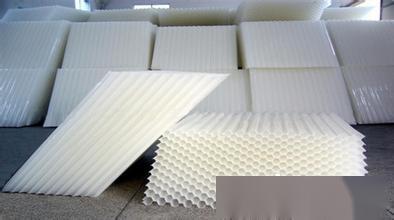The honeycomb inclined tube is a commonly used sedimentation tank filling material in the water treatment industry. However, the quality of the honeycomb inclined tube filling material determines its service life and the smoothness of the welding and installation process. Now, Jinrong's honeycomb inclined tube experts will teach you how to distinguish the quality of the inclined tube filling material. The hexagonal honeycomb inclined tube comes in two types: inclined tubes and straight tubes, and the materials available are polypropylene (PP), polyvinyl chloride (PVC), and fiberglass.
Application range of honeycomb inclined tube filling material:
The honeycomb inclined tube is mainly used for various sedimentation and sand removal purposes. It has been widely adopted in water supply and drainage projects over the past decade and has become a water treatment device. It has a wide application range, high treatment efficiency, and occupies a small area, among other advantages. It is suitable for sand removal at the inlet, general industrial and domestic water sedimentation, wastewater sedimentation, oil separation, and tailing concentration treatment. It is applicable for both new projects and the renovation of existing old tanks, achieving good economic benefits.
Specifications and prices of hexagonal honeycomb inclined tubes: The specifications for drinking water sedimentation inclined tubes are φ35X0.45 and φ35X0.5, and for wastewater, they are φ50X0.45, φ50X0.5, φ80X0.6, and φ80X0.8. The price of honeycomb inclined tubes for drinking water is higher because they must meet drinking water standards and must be made of non-toxic PP material. Prices range from over 400 to over 500 yuan per cubic meter, while the prices for wastewater honeycomb inclined tubes range from over 300 to over 400 yuan. Dongying's honeycomb inclined tube prices are reasonable, with manufacturers of hexagonal honeycomb inclined tube filling materials, honeycomb inclined tube filling material prices, honeycomb inclined tube filling materials, honeycomb inclined tube filling material manufacturers, polypropylene honeycomb inclined tube filling materials, ethylene-propylene copolymer honeycomb inclined tube filling materials, Hongda company's honeycomb inclined tube filling material prices, honeycomb inclined tube filling material welding processes, and supply information. Honeycomb filling materials come in inclined and straight tube types, with two material options: PP and PVC. The inclined tubes are mainly used for sand removal at the inlet of water supply and drainage projects, sedimentation of industrial and domestic water, wastewater sedimentation, oil separation, and tailing concentration treatment. They can also be used for the renovation of old tanks. The main features include a large wet perimeter, small hydraulic radius, good laminar flow state, and particle sedimentation not disturbed by flocculation. The straight tubes are used in tower-type biological filter pools, high-load biological filters, and submerged biological filters (also known as contact oxidation tanks), as well as microbial carriers for biological discs. They mainly perform biochemical treatment of industrial organic wastewater and urban sewage, achieving a treatment efficiency that is higher than that of activated sludge tanks, while occupying a smaller area. The aeration intensity is lower than that of activated sludge tanks, and there is no need for sludge return. The amount of sludge generated is small, with strong adaptability, greatly reducing the workload of sludge treatment after dewatering. The filtration process currently often faces issues such as caking on the surface of the sand layer or clogging of the filter layer, resulting in actual backwashing intensity and time far exceeding design parameters. This is also due to the comprehensive biochemical reactions caused by the residual microorganisms, degradable organic substances, and dissolved oxygen in the effluent from the oxidation tank. Since most design processes adopt post-filtration disinfection, the aforementioned biochemical reactions continue during sedimentation and filtration. To ensure the normal operation of the clarification process, it is recommended to use pre-filtration disinfection processes. The Qingdao beer wastewater biochemical treatment process has adopted pre-filtration disinfection for 15 years without any clogging issues in the filtration devices. When filtration is used, it is recommended to increase the charcoal layer with trace aeration to form a biochar process, with an aeration intensity of about 5% of the water volume, which can extend the regeneration cycle. Dongying's honeycomb inclined tube prices are reasonable, and the hexagonal honeycomb inclined tube uses imported modified ethylene-propylene copolymer plastic as the material, which is formed into hexagonal tubes through infrared constant temperature mechanical stretching and then welded into a complete product using patented technology and high-frequency welding, ready for installation at the customer's site.
The honeycomb inclined tube is mainly used for sand removal at the inlet of water supply and drainage projects, sedimentation of industrial and domestic water, wastewater sedimentation, oil separation, and tailing concentration treatment. It can also be used for the renovation of old tanks. The main features include a large wet perimeter, small hydraulic radius, good laminar flow state, and particle sedimentation not disturbed by flocculation. In addition to being used for water purification and wastewater treatment in chemical plants, domestic sewage plants, coal mine water treatment, coal washing plant water treatment, power plant concentration tanks, tailing water treatment, pharmaceutical factories, and paper mills for sand removal and rapid sedimentation, oil separation, and tailing concentration, it is especially beneficial for the renovation of water treatment plants and wastewater treatment projects.













